
The Way My Parents Love Me Cure an Unlucky Hangover p. 16 p. 8 Staying Informed A Means for Self Love p. 18 p. 11 Chase Petra Q&A Corps, Consumers, and Carbon p. 22 p. 13 volume 22 — issue 9 fortnightly student magazine

ART
Art by Laura Kuchar
Fortnightly Student Magazine
Volume 22 Issue 9
©2022 The Wake Student Magazine. All Rights Reserved.
Established in 2002, The Wake is a fortnightly independent magazine and registered student organization produced by and for students at the University of Minnesota. The Wake was founded by Chrin Ruen and James DeLong.
Disclaimer: The purpose of The Wake is to provide a forum in which students can voice their opinions. Opinions expressed in the magazine are not representative of the publication or university as a whole. To join the conversation email eic@ wakemag.org.
Editor-in-Chief
Managing Editor
Cities Editor
Voices Editor
Online Editor
Copy Editor
Music Reviews Editor
Multimedia Producer
Multimedia Editors
Srihita Raju
Sophia Goetz
Vishalli Alagappan
Carter Starkey
Quinn McClurg
Abby Vela
Peter Nomeland
Ben Villnow
Natalie Aue
Kailee Baumann
Cities Interns: Sydney Peshon
Voices Interns: Devna Panda, Goamaar Paul
Features Interns: Maddie Roth, Joshua Kloss
Online Interns: Bianca Llerena
Copy Editors: Vern Nowakowski, Hana Handzija
Music Reviews Interns: Shanna Sivakumar
Executive Director
Creative Director
Finance Manager
PR/Ad Manager
Social Media Manager
Art Director
Web Manager
Distribution Manager
Designers
Editorial Production This Issue
Writers
Sydney Peshon, Marie Ronnander, Jessy Rehmann, Ashley Harris-Houdek, Mansee Mane, Joshua Kloss, Devna Panda, Quinn McClurg, Caroline Ray, Max Pritchard, Anthony Vystoropski, Rogan Isbell, Shanna Sivakumar, Cheyney McKinney, Tate Schloesser, Jonathan Santiago, Peter Nomeland
Creative Submissions
Laura Kuchar, Kat Regas
Marie Ronnander
Laura Kuchar
Maggie Huang
Gracie Kibort
Makayla Hilluka
Natalie Williams
Brennan Neuser
Selam Gerezgiher
Makenna Larson
Mallory Paul
Kat Regas
PR/Ad Interns: Cheyney McKinney, Jacob Nelson
Art Interns: Sana Ikramuddin, Alex Kozak, Brooke Lambrecht
Art
1 Natalie Williams, 2 Sana Ikramuddin, 3 Brooke Lambrecht, 4 Beatrice Handlin
Cover and Feature Art: Alex Kozak
Feature Spread Design: Mallory Paul
Afterlyfe, Cracker Island, Cocaine Bear, Ant-Man and The Wasp: Quantumania, Quest of Fire, and Tennis images from original sources.
The Wake Student Magazine 126 Co man Memorial Union 300 Washington Avenue SE Minneapolis, MN 55455
THE WAKE Pinterest
TikTok
Instagram @thewakemagazine Facebook
Wake Magazine Twitter
Web wakemag.org
@thewakemagazine
@thewakemagazine
@The
@the_wake


3/20 -


Step into the natural habitat of Otters and Others with the art of Kat Corrigan. This event is held at the Minnesota Valley National Wildlife Refuge, holding the viewer to a deep appreciation for the world around them.
3815 American Blvd. E.
3/20 - 9/30
Saint Paul Gangster Tour
Explore 1930s Saint Paul: the hub of bootlegging and mob activities. The tour starts in the Wabasha Street Caves which was formally dubbed “Castle Royal Gangsters nightclub.” The entire ride will be narrated by your very own local gangster or his mol.
215 Wabasha Street South
3/23 - 4/1
Planting Party
Bring $10 and your own empty pot to plant any annuals you want at the Zywiec’s Garden Center. If you’re worried for your plants’ life in the trepid cold, have no fears. They will be taken care of until the weather gets warm.
10900 E Pt Douglas Rd
3/26 @ 8:30 - 2:30PM
Maple syrup season is in full swing and this must be celebrated. Enjoy an allyou-can-eat breakfast with pancakes, sausage, co ee and orange juice. Sounds like a splendid Sunday.
Minnesota Landscape Arboretum
3/31 & 4/1 @ 8:00PM
Lemi Ponifasio: Love to Death (Amor a la Muerte)
Surround yourself with the language, voices, and bodies of Chilean artists as they tell a story of Chile’s history. The work questions femininity, nature, power, and destiny in a harmonious balance that pushes towards activism.
Walker Arts Center
3/25 @10AM - 2PM
Uncovering Ancient Climate
Find out about the extreme landscape and climate change that North America experienced during the Cretaceous period. There will be fossils, maps, and scientists around all corners.
Bell Museum
5 THE WAKE INSIDE UPCOMING EVENTS 8 9 10 11 13 16 17 18 19 20 22 How to Cure an Unlucky Hangover Chemical Aftermath MN Codifies the ‘Fundamental Right’ to Abortion Saving Ourselves from Apathy A Means for Self-Love or the Male Gaze? Corporations, Consumers, and Carbon: Who’s to Blame Here? The Way My Parents Love Me Letter to the Eccentric To Luddite or Not to Luddite? Staying Informed Without Staying Stressed How TikTok has Changed Music Discovery Six Reviews Chase Petra Q&A
4/2 Wild and Precious Life
Pancake Breakfast
Maplefest
Letter from the Cities Editor
Dearest gentle reader,
I write you this letter while listening to the Bridgerton soundtrack, so allow me to borrow the above salutation from Lady Whistledown. I recall my hesitancy to watch Bridgerton since it was described to me as an elegant version of Gossip Girl set in the British regency period with diverse casting. I wasn’t like the other young ladies, you know, I only watched niche, cult-classic television. I was shackled to this idea that to be unique and authentic was to diverge from what was mainstream. Thus, I never allowed myself to enjoy the music of pop artists nor watch reality television for the fear of being a “basic b*tch.” However, to be stuck in this tale as old as time immemorial, was not my desire. In the past two years, I have flung open the gates to my heart, urging any and all musical artists, television writers, podcasters, and authors to excite me anew.
This process, though, has met its fair share of obstacles along its path. The population of “cool” people at the Wake is abounding. On the one hand, I was thrilled to work amongst such inventive, authentic colleagues, but on the other, I was abashedly intimidated by them. I find myself lost, unable to wander back into the comfort of 80s English rock bands, nostalgic sitcoms, and kids TV nor embrace the light of Lizzo and Stranger Things. Media that I previously exalted as “cool” when I was amongst my peers in STEM, wasn’t cool enough, according to my own biased scrutiny, when I was at the Wake.
This untenable quest of mine to be suave and admirable that was exacerbated by working at the Wake is evanescing, ironically, by working at the Wake. I am slowly recognizing that I sit amongst friends that consume media that pleases them and adhere to fashion trends that energizes them.
I notice their eyes light up when talking about a certain celebrity or subreddit they like during our icebreakers and sta presentations. I bear witness to their true, authentic, and unapologetic selves. I see how creative and passionate my colleagues are and it inspires me to explore and find my niche in this expansive world, rather than conform to what I believe identifies me as a member of the cool coterie.
Likewise, our writers who so vulnerably illustrate similar experiences have alleviated the loneliness I endure as a byproduct of this identity crisis. The Wake o ers a place of refuge for a lot of the contributors, including myself. Albeit the fact that I don’t write so much anymore, when I do write for the Wake, I am permitted to not only unburden myself of my chaotic thoughts and sentiments, but also discover and acknowledge revelations previously unbeknownst to myself.
I elected to focus on this aspect of how the Wake has influenced my existential journey because the opportunity to write of my experiences and my identity, or in this case, my lack of clarity in that concept, drew me to the Wake as a bright-eyed first year.
As an end to this rabling piece of correspondence, I commend you to draw inspiration from the Wake sta and independent contributors and commit yourself to the adventure of self-discovery and self- growth.
Yours truly.
Lady Vishalli Cities Editor

6 MARCH 20 – APRIL 10

3
ART
Art by Kat Regas
How To Cure an Unlucky Hangover
A quick guide to remedy a night of drinking
BY SYDNEY PESHON
As someone who has thrown up on the side of Highway 52 after a night of birthday bar hopping, I’ve experienced a fair amount of hangovers. Although the only real way to avoid hangovers is to drink moderately and take shots of water instead of alcohol, here’s a short list of things you can do to soothe a pounding headache, the nag of nausea, and the harsh sight of sunlight.
1. Load up on liquids. Whether it takes investing in some MiO, chugging neon bottles of Gatorade, sipping a bit of Pedialyte, or drinking the juice straight from a pickle jar, liquids will be your best friend when helping fight o a hangover. Better yet, be sure to drink a big glass of water before you head to bed the night of.
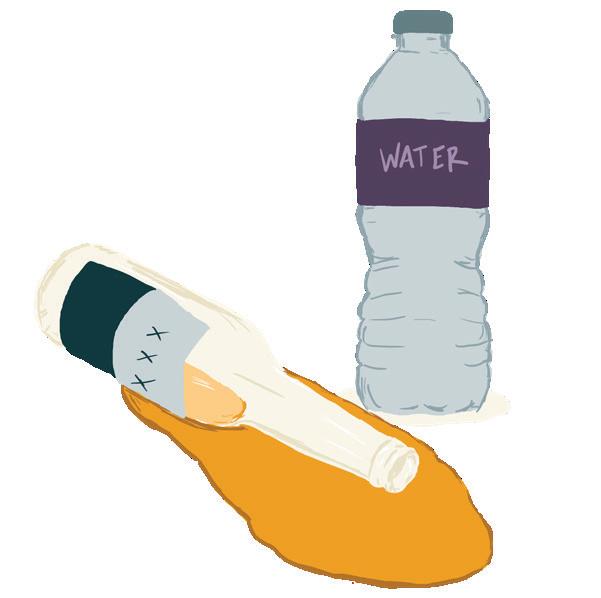
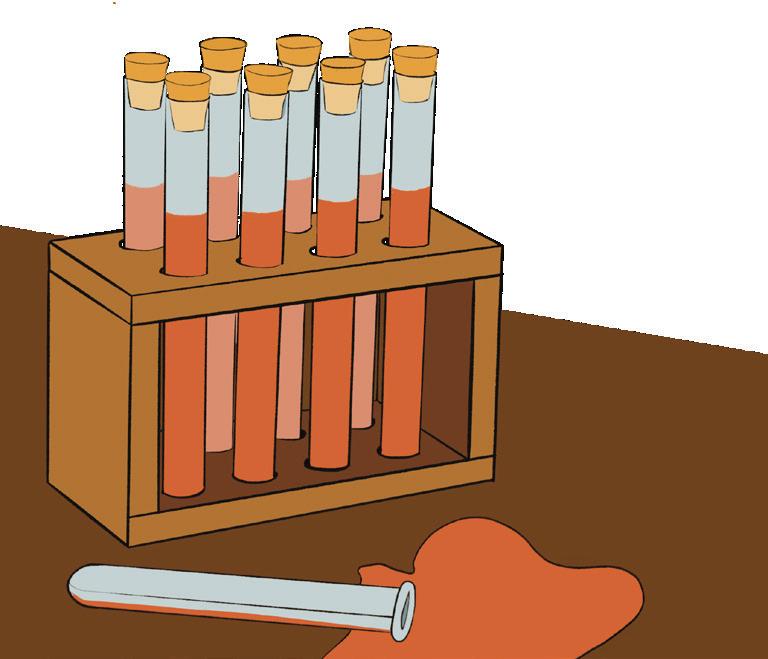
2. Scarf down some carbohydrates. I’d suggest heading on over to the Uptown Diner to eat a humble amount of greasy hash browns and buttery biscuits (the Cajun breakfast is my all-time favorite), grabbing a breakfast bagel from Rise Bagel Co., or consuming an entire sleeve of Saltines.
3. Take pain relievers (anything other than Tylenol), vitamin B, and zinc. These can help lower the damage to your liver and lessen the severity of your hangover.
4. Catnaps, time, and patience—it’s frustrating not being able to take a magic pill to skip the side e ects of drinking more than you should’ve, but this is the only true cure for helping nurse a hangover. Alcohol disrupts your sleep, so catching up the next day will help with the fatigue.
Make sure you don’t save a big assignment for the day after a long night out, drink responsibly, and enjoy a nice hangover breakfast!
Chemical Aftermath
The demons that sunk into the soils and spoiled the water
BY MARIE RONNANDER
Before asbestos was a fear-striking carcinogen, it was hailed as a miraculous flame-resistant super fiber. The same lead that poisoned the water supply of Flint, Micchigan, used to be Queen Elizabeth I’s makeup. Chemistry is an ever-nebulous world full of Schrodinger’s cats and unanswered postulates. What we do know about the chemical spill of East Palestine is that each chemical split was well-established as dangerous..
Acyl chloride, butyl acrylate, and isobutylene are amongst the toxins sloshed onto the earth after the train ran o course. To any life science major, these names bring back a reverie of organic chemistry nomenclature.They sound harmless enough, but each chemical brings about a slew of intimidating symptoms when exposed to. Gaseous butyl acrylate blisters the skin while isobutylene induces intense nausea and brain fog. But what happens when these pollutants build up in our environment?
The government’s hope is to avoid this possibility entirely. The area’s soil was sucked up and forced under a controlled burn in the hopes of avoiding a massive explosion. The opportunity cost however, is unknown. Burned acyl chloride readily transforms to phosgene—a nasty little chemical that has the ability to cause respiratory failure in just a few sni s. Though the area has been cleared, there’s fear that the vinyl chloride could stick around in homes and transform with the onswitch of an oven.
The truth is we don’t know how this spill will play out. How these chemicals interact with the environment is under-researched. Citizens are complaining of pungent chloride-like fumes while at least 43,000 animals have been reported dead. Flint, MI, su ered their first casualties in 2015, and there are still pipes waiting to be replaced. The government is good at rapid response, but fails to follow through in the long-term.
8 MARCH 20 – APRIL 10
CITIES 2 1
MN Codifies the ‘Fundamental Right’ to Abortion: All Your Questions Answered
Hold up… what does codify even mean?
BY JESSY REHMANN
Minnesota has taken a monumental step in protecting access to reproductive health care.
On Jan. 31, 2023, Minnesota became the first state to codify the right to abortion since the overturning of Roe v. Wade last summer. Codification means that a piece of legislation is enacted and systematized into the collection of laws at the local, state, or federal level. This ensures that the laws of a government are clear, consistent, and not contradictory.
By codifying the Protect Reproductive Options Act (PRO Act), the Minnesota Legislature guaranteed what the law states is “a fundamental right” to reproductive health care. This includes access to abortion, contraception, sterilization, maternity care, fertility services, and more.
This decision, like anything in politics, may raise some questions. Since this new law a ects all of us here in Minnesota, it’s important to understand what it means for our state. Here are the answers to some of the big questions you may have.
What does codifying abortion access do? Whose rights are protected?
Codifying abortion rights in Minnesota makes the procedure legal and protected as statutory law. This means that the law is permanent and has strict language, which limits how courts can interpret it. The PRO Act also uses gender-inclusive language by stating that “every individual” can “make autonomous decisions” in regard to their reproductive health. As a result, every person in Minnesota has the right to abortion access. This applies to Minnesota residents as well as outof-state residents. Therefore, this law cements
Minnesota’s role as a safe haven by providing abortion access to people living in neighboring states with harsh restrictions.
Why did MN codify abortion access if the procedure was already legal in the state?
Abortion access has been legal in the state since the 1995 Minnesota Supreme Court ruling of Doe v. Gomez, which ruled that the right to abortion was secured under the state’s constitution. However, since this was a judicial ruling and not an enacted piece of legislation, it ran the risk of being overturned in the future. The codification of the PRO Act, therefore, acts as a second shield to protect access to abortion.
Are there any restrictions or gaps in this legislation for abortion access?
While the wording in the PRO Act is pretty comprehensive and inclusive, it doesn’t address the abortion restrictions that are currently codified into Minnesota state law. Some of those restrictions include a 24-hour wait period to obtain an abortion, two-parent notification for minors seeking an abortion, the requirement that only physicians can perform abortions, and mandatory informed consent (a process that can include biased and unfounded information against abortions). A Ramsey County judge ruled these limits unconstitutional last summer, so they are not currently enforced. However, if these restrictions remain codified, a judge could overturn this ruling in the future and they would once again go into e ect. Minnesota Democrats have been working to pass another bill that would remove these conditions from state law. At the time this article was written, the bill was on the agenda for discussion in the House.

What does this codification mean for the future of our state?
As previously mentioned, the codification of the PRO Act further established Minnesota as a safe haven state; a place where people from states with abortion restrictions can legally obtain access to the procedure. After the reversal of Roe v. Wade, Planned Parenthood reported a 13% increase in patients from outside the North Central region traveling to these states to access safe abortion care. This rise in out-of-state patients could make it harder for Minnesota residents in metro areas to get abortion appointments at their local clinics. The Pew Charitable Trusts reported that clinics in the state’s northern regions, which are more remote and isolated, have not seen the same increase of non-Minnesotan patients as the state’s southern cities. Consequently, Twin Cities residents may need to travel farther to get access to timely abortion care.
Even so, Minnesota’s role as a guardian of reproductive rights provides essential access for people who otherwise would not be able to get this care. The codification of the PRO Act sets a powerful example for other states as the nation continues to navigate abortion access post-Roe v. Wade. This legislation is just the first step in granting safe, legal, and timely abortions equitably to people in Minnesota and across the United States.
9 THE WAKE CITIES
3
Saving Ourselves From Apathy: Building Community With the Homeless in Dinkytown
BY ASHLEY HARRIS-HOUDEK
With the snow billowing during these last few weeks of February 2023, I cannot help but consider the frozen toes and fingers of our neighbors with no home. They watch us on the corners as we are able to go home at the end of work or class, get cozy with blankets, have a nice warm meal (even if it’s just ramen) and watch the newest Netflix documentary.
Meanwhile, they are standing outside, with absolutely no one giving them a reason for hope. When your entire society treats you as a ghost, it is hard to desire to continue living. As a previously homeless individual, what I have found most bright in the greatest darkness was the ability that the poor have for sharing, even if they have nothing left to give. Those who have grown up in poverty know that sharing is a true means of survival, but also makes everyone more happy and puts much more value on items purchased. The entitlement to possession and the belief that we have a right to material goods is a part of what is rotting our society from the inside out. To rid ourselves from this attachment to “mine” is true freedom, as it puts value more on each other than a commodity.
I talked to a man named Picho on the metro as I was riding back to Dinkytown. He asked if anyone knew of a shelter nearby. The bus was quiet, everyone looked ahead, as if he was not real. I told him I could look up a place on maps.
Our actions determine who we are as people. It is often the hardest to do good when it is not the popular thing to do. I gave him all the snacks in my backpack, and while handing them to him, I felt his hands. They were stone cold. He told me last time he was eating at McDonald’s, he was kicked out, despite buying a meal, because his friends were loitering. Even when the homeless do the right thing, they are still punished for their poverty. This is textbook discrimination.
Respect is the most important thing you can give to the homeless. To look a man in the eye and ask him what his name is, is to acknowledge that he matters as a person in society. I know I simply cannot live with myself buying a meal when I know the man outside is starving. Nevertheless, why would I want to eat alone? The fruits of our labor are meant to be shared.
We are social creatures, and I truly believe we share the one unifying consciousness, the same emotions. When we see su ering in our society, there is su ering within ourselves. Delusion is very dangerous, and to ignore the starving man on the street is to ignore our own starving hearts that beg for love and community. My whole childhood I have been shy, but when you understand the social anxiety within you is within everyone, it begins to dissolve. When we forget how similar we are, there is a blockage in communication.
Where are the “compassionate capitalists” , the “christians” and “socialists”, black square “activists”, or “philosophers?” I know my fellow students are likely identifying with one or more of these labels, yet turn a blind eye, every time. I feel sometimes as if I am going insane with the socialized acceptance of injustice. There is a reason your heart burns with uncomfort at the site of extreme poverty.
It is so easy to blame the powerful, yet what maintains inequality is public opinion. Imagine if every homeless man and woman on the corner were a young child, would you still allow them to go cold and hungry passing by? Are we not all originally children?
I will leave you to consider this, my friends of the Wake audience, a quote from philosopher Jiddu Krishnamurti:
“All great things start on a small scale, all great movements begin with individuals; and if we wait for collective action, such action, if it takes place at all, is destructive and conducive to further misery. So revolution must begin with you and me.”
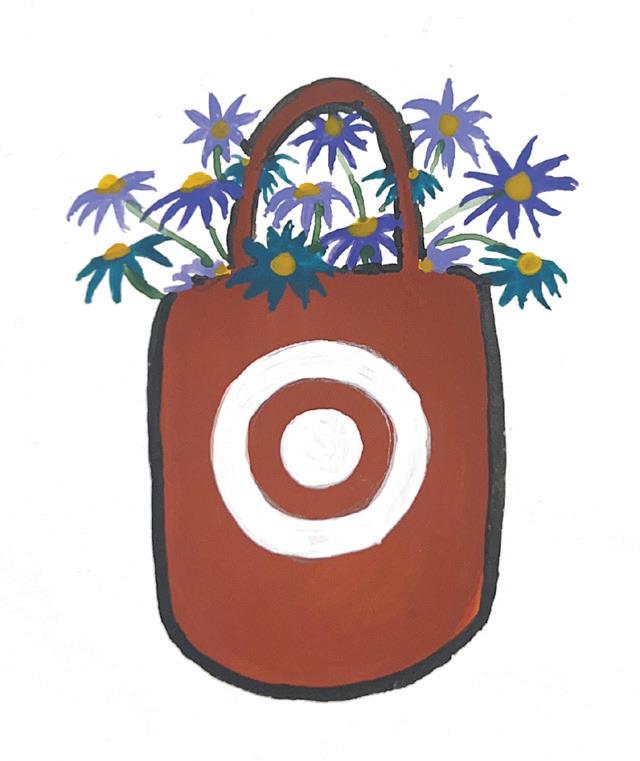
10 MARCH 20 – APRIL 10
CITIES 3
A means for self-love or the male gaze?
Silly little intrusive thoughts about makeup and sexist oppression
 BY MANSEE MANE
BY MANSEE MANE
I love taking my time to get ready in the morning. From the sing-a-long hot shower and the perfectly runny eggs to the excitement of mixing and matching pieces of clothing I’ve collected throughout the years, my mornings are a ritual. But my favorite part of the morning is doing my makeup. I find immense joy in exercising my creativity every day. It’s fun trying new techniques and products. Plus, the satisfaction of coordinating my makeup with my outfits is unmatched.
However every once in a while, in between the stroke of a brush and the flick of a lash, I pause; I’m in a dilemma. Who am I doing my makeup for? Is the art I love really an act of self-care? Or am I just submitting to the gender roles laid out for women? Is this skill I have cultivated throughout my youth merely my internalization of the male gaze? If so, can I really call myself a feminist?
First, I want to clarify what kind of feminist I’m talking about. When it comes to feminism, I’m in the camp that defines it as a movement to end sexist oppression. This entails liberation from the patriarchy, dismantling the gender binary, and freeing everyone (yes, men too) from all types of types of oppression (psychological, economic, social, political etc). One manifestation of this sexist oppression is the concept of beauty standards.
For centuries and across many societies, women have been told that their worth rests upon their ability to bear children, their submissiveness, and— of course—-their beauty. Women’s status as human beings was diminished to “lesser-than” based on our gender. Although it is not as overt as it was in the past, women are still expected to uphold these standards set by men. Pretty privilege is a great example of how these standards translate into our society today.
So, like, what am I supposed to do with all this information? I love makeup, but can I really say I do it for myself when all my life society has been telling me it’s expected of me as a woman? This is the struggle of feminist consciousness. We come to realize that so much of the world around us is made to cage us in, that oppression is woven into the fabric of our society. Even in something as trivial as makeup.
I’ve made peace with my dilemma because I experiment with my makeup. I play with gender in my looks, and I push back on beauty standards by finding beauty in my own creations. I genuinely find joy in it; I’m not begrudgingly putting on a face to look presentable. I realized I’m not less of a feminist for engaging in this art form because I view it as that—an art form.
This is just how I dealt with the push and pull between beauty standards and self-love. This journey looks di erent for everyone, and I am not saying that there’s one “right” relationship to have with makeup. Rather, I’d like to encourage everyone to think about how we interact with gender norms, and critically assess why we participate in them. Everyone is performing gender all the time, it’s just a matter of whether we’re aware of it or not. At the end of the day, how you present should make you feel comfortable, confident, and authentically you. So whether that means colorful graphic makeup, a soft-glam beat or a freshly clean face, do it with love and intent.
11 THE WAKE CITIES
1
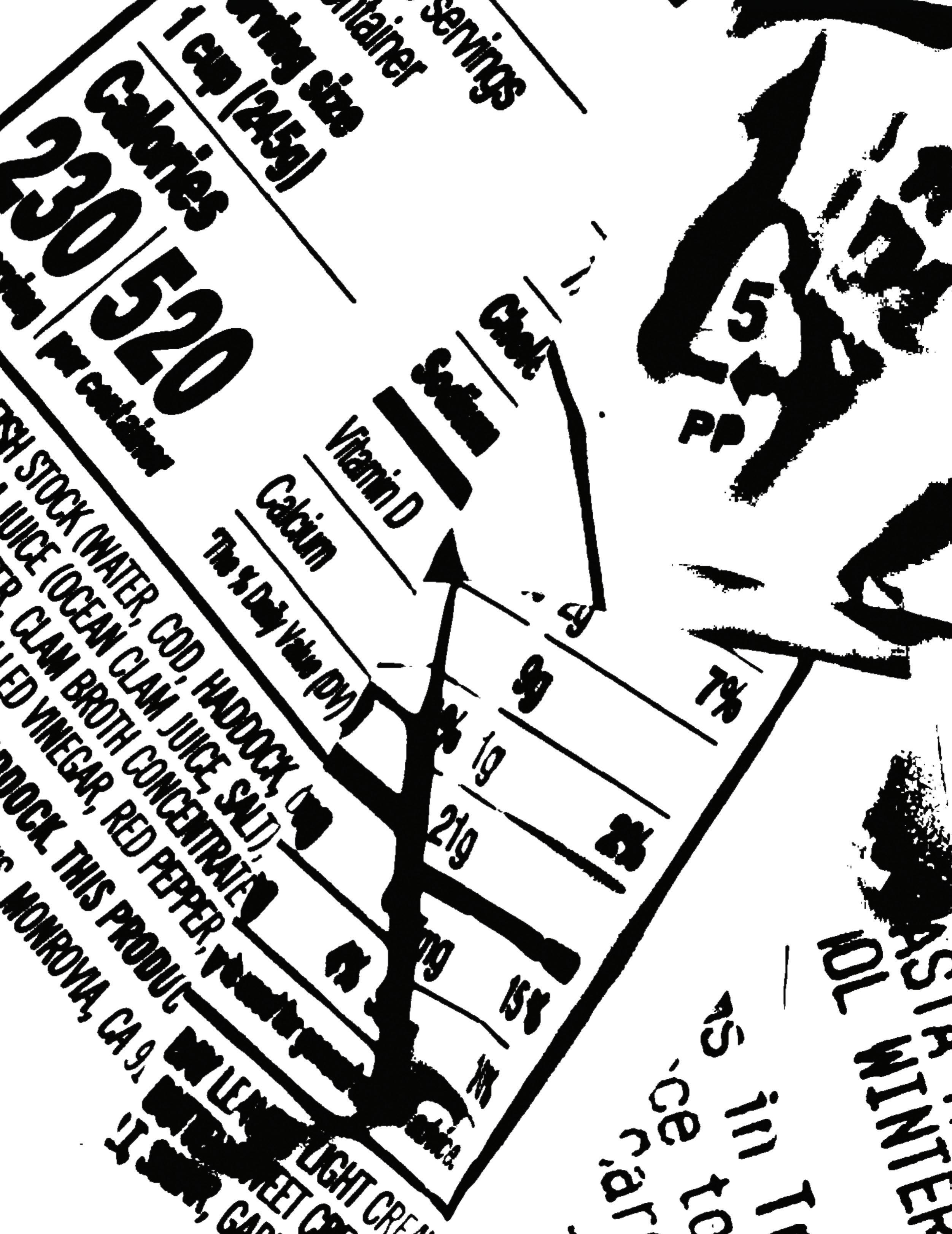 Art by Laura Kuchar
Art by Laura Kuchar




You know the guilt, and so do I. The guilt that creeps up on each of us when we forget to bring a reusable cup to Starbucks for our morning co ee and have to walk out with a Venti cup of plastic. Or that shame that bubbles in the pits of our stomachs when we recycle a product that, in reality, was designed and destined for a landfill. It’s a hurtful guilt, and a righteous one at the same time. It’s okay to occasionally feel bad about our environmental activism; in fact, it just pushes us to consider ways we can do better. We can all do better to lower our carbon footprint.
Oh, but, wait! Should we? Carbon footprints were derived from the idea of the “ecological footprint,” a term coined by scientists at the University of British Columbia in the nineties. British Petroleum, or BP, took the concept and ran with it, going so far as to invent a “carbon footprint,” calculator and launch an advertisement campaign in 2003 that encouraged people on the street to calculate their own footprints. It was all a stunt from BP that pushed the narrative that individuals should change their own lifestyles and behaviors in order to combat climate change.

But I’m here to assure you that, no matter how detrimental you consider the plastic straw in your Dunkin refresher, you are not the one that should feel the weight of environmental doom. Many activists have since criticized BP and other large oil companies for their blatant hypocrisy, as they are responsible for a ba ing amount of emissions compared to the average individual. Not to mention they are responsible for billions of dollars worth of damage from the oil spills that happen under their watch and lazy practices. The ExxonValdez and BP Deepwater Horizon spill were each several billion dollars of damage, and the justice
for the individuals and communities a ected has since been nothing short of lackluster. Yet, these giant corporations continue to attribute climate change towards individualistic actions, as seen with BP’s carbon footprint craze. Huh.
To highlight the discrepancies between the individual and the corporation, let’s circle back to our greedy, not-so-little and not-so-friend, BP. Alongside other oil giants ExxonMobil, Shell, and Chevron, BP was listed as one of the highest emitting investor-owned companies since 1988. Going further down that list, we have a cohort of 100 total corporations who have been responsible for a whopping 70% of all global emissions since 1988. Read that however many times you need to until you get scared, and then keep reading until you’re furious.
So, maybe one single person shouldn’t feel so bad about using a plastic straw. After all, corporations do everything in their power to maximize their profits. If one argues that corporations are obligated to pay back their shareholders, one
could also argue that they owe it to us, as both their consumers and laborers, to invest in a sustainable future. That doesn’t mean solar panels and electric cars by the end of the day tomorrow, but maybe at least a future where the rivers run free of oil-slicked water and we don’t consume a plastic-card worth of microplastics every week (according to a study run by the World Wildlife Fund. But don’t worry, that’s only an approximation!).
You see, it’s one thing that corporations are polluting at such grave amounts, especially when there’s only a handful of them and almost ten billion of us (can’t we share the planet equally?). It’s another thing that they are unfathomably wealthy, and have both the money and power (though the two are just about the same) to enact action. To put it at its simplest, if corporations have the right to mutilate our planet in their reckless pursuit of capital, they could at least use some of that capital they accrue to fix what they’ve caused. And trust me, they have caused a lot.
Many corporations are actually seeing recordbreaking profits, yet they are still hungry for more. Recently in East Palestine, Ohio, a train run by the railroad company Norfolk Southern derailed. 20 of the 51 cars that crashed were carrying hazardous materials, and people were forced to evacuate their homes only to return later to rivers that run with an oily sheen on the surface, their pets and livestock dropped dead, and little-to-no cleanup from the local and federal government, though as of recently, the Environmental Protection Agency (EPA) has gotten involved. During the Trump administration, Norfolk Southern lobbied for legislation that laid back requirements for freight trains carrying hazardous materials. It
14 MARCH 20 – APRIL 10
FEATURE
e ectively allowed Norfolk to avoid installing electronically-controlled pneumatic brakes on trains that carry materials of mass destruction. Who knows how things would have played out had the train that derailed been equipped with faster, more e cient brake systems. Or if Norfolk Southern remained up-to-date on their wheel bearing temperature sensors, which could have reportedly helped the derailment situation in East Palestine in the first place.
Why did the CEO of Norfolk Southern, whose salary was $4.2 million as of 2021, lobby against stricter regulations? Because those cost money, and money that’s going into the pockets of corporations hardly ever finds its way out. After all, Norfolk Southern, like so many other corporations, are beholden to their wall street investors and shareholders, which cause them to act in ways
that avoid spending (so, no strict regulations) and that maximize revenue.
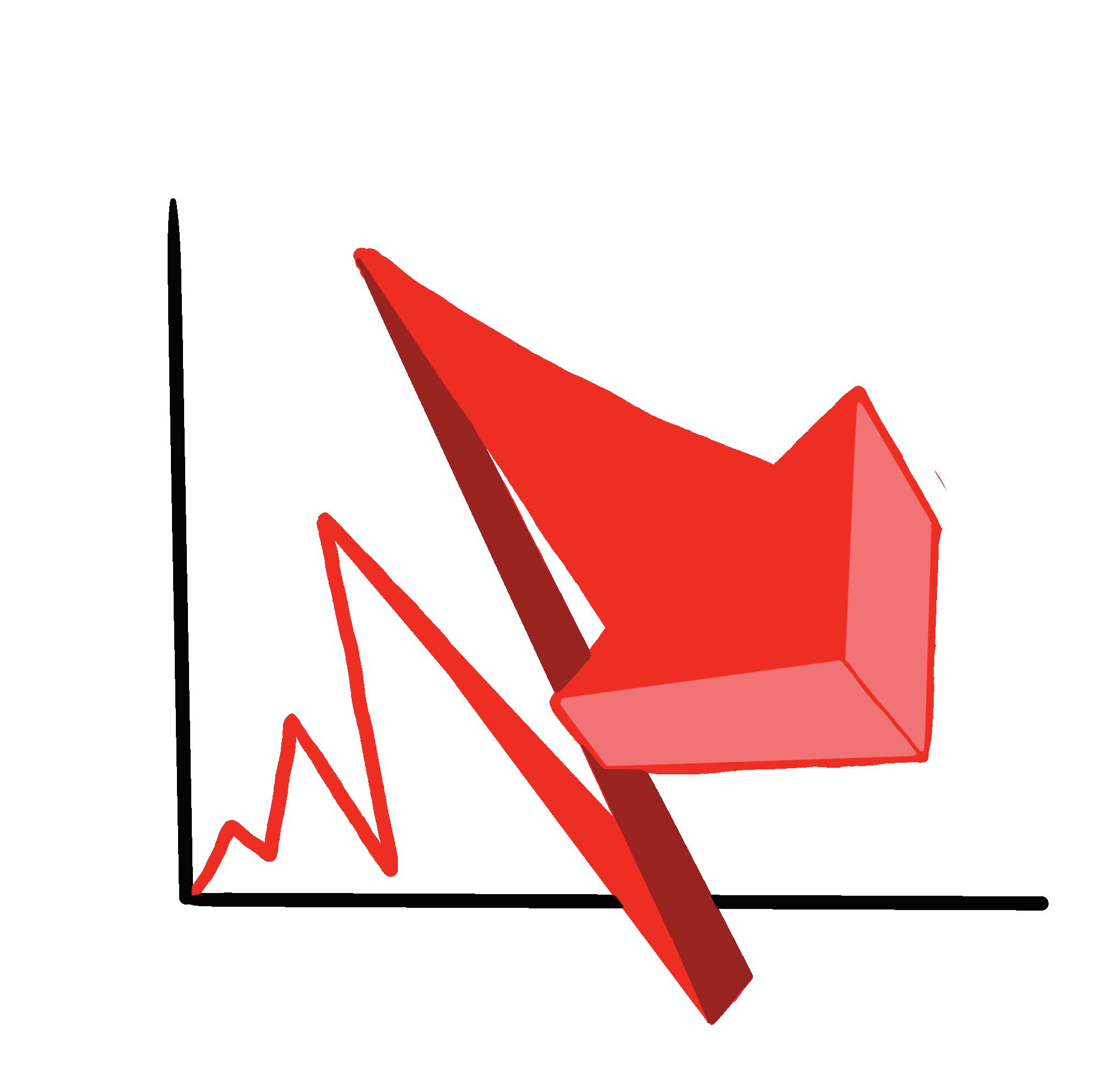
Here’s another thing to sit on: if you made about 19 million dollars a year since the year zero (so, $20,000,000 x 2023 years) you still would not have made as many profits as Shell did in the year 2022 alone. To be clear: I cannot even imagine what $20 million looks like in cash. The fact that Shell has made that amount of money (about $40 billion, to be exact) in one fiscal year alone is absolutely mind-boggling. That was the highest salary on record for them, nearly doubling since the year prior, highlighting the fact that corporations continue to see record breaking profits. And yet, these companies are the same ones who resist even paying to clean up the oil they spill into our oceans and onto our coastlines.
To be clear, it is wonderful that people care about the environment. I myself have been vegan since my sophomore year of highschool to help mitigate my own “carbon footprint,” and I will always applaud my friends and family that also make conscious decisions in order to live more sustainably. But, I’ll ask you this: how much money do you make a year? Anywhere close to $40 billion, or $20 million? I didn’t think so. Obviously, you’re not the one who should be paying to clean up the planet; we’re all living in a world where we must buy products from the same corporations that are walking all over our planet.
But, still, maybe the monthly Shein hauls that border in the hundreds of dollars are a bit ridiculous? Because, after all, we’re not helpless. Nor are we powerless. As consumers in a crumbling capitalist country, we speak most loudly with what’s in our bank accounts. We can choose to spend money at thrift stores instead of supporting companies that charge upwards of $40 for a graphic tee yet still outsource their labor to foreign countries where they can source sweatshop labor from (looking at you, Urban Outfitters… and a handful of other clothing brands).
Ultimately, environmental justice intersects with every other section of activism. That’s why we have terms like environmental justice: because so often of the time, the act of polluting is not a victimless one. The communities such as Mossville that were forced out by Sasol’s petrochemical plants in Louisiana’s strip of Cancer Alley still don’t have justice, for example, and neither do the people of East Palestine so far. The fight for sustainability is one against capitalism. If at one point this statement provoked you, I hope that after reading this article, you find it to be old news.
15 THE WAKE
FEATURE
The Way My Parents Love Me
BY DEVNA PANDA
Moms are the sensation of sleeping soundly through the night, nestled comfortably in a warm blanket. Warming your chapped hands on the kitchen stove. Rounding the corner onto your neighborhood block after coming home from a long journey.
Dads are the feeling of comprehension after finally internalizing a di cult concept. Driving during a storm, impervious to the rain. Seeing a familiar face in an unfamiliar city.
Every morning, when my Mom dropped me o at preschool, I would tear up at the thought of spending the morning apart from her. As tears filled my eyes, I would turn to my Mom and declare that I’d make her proud. With a small smile, she would squeeze my hand and leave the classroom.
I have always felt very connected to my parents, so naturally being away from them when beginning college was challenging. On the first night, as my parents’ car pulled out of the Middlebrook Hall parking lot, despite being a mere twenty-seven minutes away from my hometown, I sobbed like a child wandering around aimlessly, lost in the aisles of a supermarket. The notion that I had moved out of my childhood home and would likely never live with my parents again was incomprehensible. As is the story for many immigrants, my parents left
their home and family in India for the opportunity to pursue upward economic mobility in the States. I have seen them take solace in their cultural community in America and appreciate all that this country has to o er. Even still, I know how they must miss the country they spent their formative years in. I have seen it in their inclination to opt for Indian food any time we travel or go out to eat, searching for India in every corner of the world we are in. I have noticed it in my Dad’s dedication to his weekly call schedule with his parents or my Mom’s desire to make payesh on birthdays as her mother would do for her when she was growing up. They moved to a foreign country in their twenties, forgoing many comforts: the luxury of holding an identity that is aligned with that of the majority or being close to their own parents. This sacrifice on their part is not lost on me. And yet, only when I actively count my blessings do I stop to consider how lucky I am to have such supportive parents. As much as I love my parents, I take my relationship with them for granted.
What’s more is that I can be quick to express frustration with my parents: for instance, when they insist on taking a picture together every time we go to a restaurant or when they ask me to retell a story. In these moments, I will remember how my parents kept up a constant stream of encouragement while teaching me to ride a bike until I was finally ready
to my training wheels o . I will remind myself of how my Dad patiently pointed out that I could easily stand in three feet of water when I was terrified of stepping into a swimming pool. I will consider how they kept their cool during the painstaking endeavor of explaining negative numbers to me no matter how heated I became. As I transition into adulthood, when I am faced with a new challenge or obstacle, my parents are my first call.
As they themselves navigated adulthood in a foreign country, my Mom and Dad prioritized holding my hand through every new experience. The least I can do is return the same patience and kindness they have given me. I know there is no other form of love I will experience in this life that will compare to a parent’s love.

16 MARCH 20 – APRIL 10
VOICES
4
Letter to the Eccentric
An admission of love in the Twin Cities music scene
BY QUINN MCCLURG

You’re at a show. The sound techs have calibrated their devices, the stagehands have tuned their instruments, and the cable runners have run their cables—now everyone waits for the performer. It’s some name you’ve never heard of, but they’re playing on the same bill as your favorite band, so they’ve got to be good, right?
Then, the spirit of a long-dead founding father materializes from the mist stage-left, powdered wig and all. You begin trembling with fear until you notice… that isn’t a ghost at all, but rather, Larry Wish.
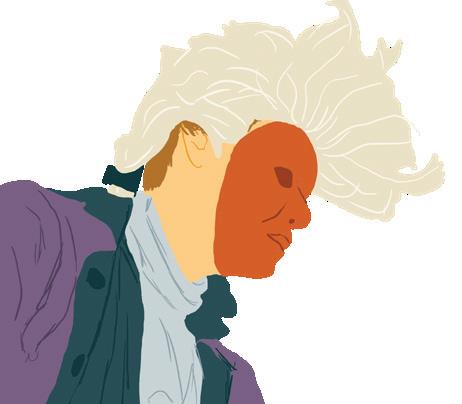
I’ve seen plenty of fantastic shows, but some performances have become consistent and predictable enough to blend together. But unusual performers—the ones who occupy the spaces between the waking mind, the sleeping mind, and the wardrobes of 90s drag queens—are the ones that make nights memorable.
Whether it consists of some unplugged-piano-playing, micstand-riding, and nursery-rhyme-synth of Larry Wish, or the babbling, undulating, audience-participating screammiasma of Mommy Log Balls, it is clear that the best unusual performances border on performance art.
And the performers aren’t alone in their eccentricity: their unusual nature often only can inspire animalistic fervor in the audience members, as if they have no idea how to react other than by embracing euphoric irony. Rarely are audiences as enthusiastic, loud, or wild as shows where all conventions are o .
If you are a performer looking to emanate this energy yourself, all you have to do is find a goofy gimmick: something that is unique to you and otherwise unheard of. Using costumes and masks like the previous examples is always a good call, especially in securing your privacy. But another good gimmick example would be Cannabis Kiss’ singing saw performances. Executed with an over-rosined violin bow and a humble Ace Hardware saw, this performance isn’t exactly of technical grace, but it can turn any basement show into a confused surge of jubilation.
These flares, both technical and visual, will set you apart from other performers, both in spectacle and memory.
As for any more of my opinion or guidance, you’re on your own—I’m not in your band, and I’m certainly not your aesthetic manager—I’m just here for the music.
BY CAROLINE RAY
Last fall, amid an identity crisis that involved dropping out of school, lots of crying, and moving to the wilderness of Maine for a job entitled “Head Cook,” I became completely isolated from technology– an accidental Luddite of sorts. My new cook position required me to move into a cabin located at the end of a dead-end dirt road with no service and only unreliable WIFI. Within the first week, my phone usage plummeted to less than 15 minutes per day, and suddenly I had almost no need for the internet or most modern technology. I kept in contact with my parents and hometown friends, mostly through calls and emails, but otherwise I rarely touched my phone and instead spent my days outside: reading, working, and writing. My job was a five-minute walk from my house, I had unlimited access to acres of public land, and I was surrounded by a group of new and interesting people. My days shrunk to the plot of land where I lived, and I thought little of the outside world. It was boring and beautiful.
Now I’m back at school in the city, and I spend most of my time online. My brief dip into Luddism–the practice of rejecting or destroying modern technology–was only possible because of the simplicity and isolation of my life. Back in the “real world,” technology is an oppressive, ever-present component of daily life, and I’m finding it increasingly hard to use it in moderation. Despite the harshness of reality, I’m trying to find a way to coexist with technology and to preserve some of the distance I fostered in Maine while still moving forward. I go on “tech-free” walks to Target. I read before bed. I delete Instagram, I redownload Instagram, and I delete Instagram again. Nothing radical, but for now it’s enough.
17 THE WAKE
My brief time off the grid and in the woods.
VOICES
To Luddite or not to Luddite?
3 1
Staying Informed Without Staying Stressed

 BY MAX PRITCHARD
BY MAX PRITCHARD
If you’re looking for a quick way to feel overwhelmed—which I sincerely do not recommend—scrolling through the front page of a major news website is a solid place to start. On the day I’ve written this, for example, a quick glance reveals that, among other things, China has aligned itself more strongly with the Russian war e ort, a French teacher was stabbed by their student, and several Palestinian civilians have been killed in an Iranian strike. All these stories are upsetting and each is unique with its own intricacies, contexts, and implications; and this is just scratching the surface of one day’s events. Unfortunately, those headlines will no doubt be added to by an ever-growing number of similarly distressing stories by the time this piece is published.
If you find yourself overwhelmed when perusing the news, you’re not alone; there’s plenty of research to back up this phenomenon. Access to 24/7 coverage of events worldwide can open a window to a neverending landscape of disasters, tragedies, and crises. Consuming too much coverage of tragic events has been found to generate acute stress symptoms, causing your body to release greater quantities of stress hormones like cortisol and adrenaline, possibly leading to fatigue, depression, and other physical symptoms.
As a result, researchers urge readers to assess their state of mind and, when needed, limit time spent on news sites and certain social media platforms. Following reliable sources is crucial, as is staying away from sensationalist or misleading reporting. Stress can be diminished by reading objective reports more than opinion pieces; though I would argue that op-eds and firshand perspective pieces are pivotal in many topics, especially those regarding marginalized groups—a balance, then, can be useful. It can also help to follow ‘good news publications’ that highlight kind acts or scientific progress. Lastly, many advise that stress can be minimized by practicing emotional self-care, investing your attention elsewhere, and centering on hobbies or relaxing activities; such habits may be di cult to implement quickly but are very helpful.
All of this advice is undoubtedly valuable and worth applying. But in doing so, I believe it is crucial not to go too far in the other direction and follow the common path of ignoring current events altogether. Staying informed is foundational to using our power and doing good. The East Palestine train derailment, for example, is extremely dispiriting to read about, but is also a vital reminder of the need for stricter environmental legislation. It is only through learning about the situation that the regulation rollbacks of the previous
administration and the lackluster federal response to the disaster can be critiqued. This is true throughout the current events landscape—it is only by staying up to date with current happenings that we can hold corrupt or faltering systems accountable and identify needed change.
So be sure to moderate your news intake, but I urge you to continue to stay as informed as you are comfortably able to. It can help to remember not to feel guilty for being unable to help with all the unjust and unpleasant events and systems that you read about; remember that there is simply too much going on for any one person to fix.
If you’re feeling helpless, it can help to ground yourself by contributing to one or two issues, however you are best able. Perhaps this can be through joining a student advocacy group, volunteering, attending rallies, or donating to important causes. There’s a lot of power to be found through individuals focusing their e orts on specific challenges. Some may center on climate, others on reproductive rights, and so on, while uplifting and supporting other issues whenever possible. Nobody can solve all the world’s problems, but through lots of people chipping away at individual ones, a whole lot of good can be done.
18 MARCH 20 – APRIL 10
Constant news coverage can be overwhelming— managing your intake is crucial.
VOICES
1
How TikTok Has Changed Music Discovery
Break through artists, remixes, and personalization.

 BY ANTHONY VYSTOROPSKI
BY ANTHONY VYSTOROPSKI
From TikTok trends to duets, TikTok is providing both a new way to discover music and changing how we discover music based on the app. In the growing age of technology, TikTok has made its name known as a platform in social media. No matter what side of TikTok you are on, the various algorithms will try and promote trending or popular music, as far as even seeing an artist attached to a particular post. It is always interesting to see just how tailored the for you page (FYP) is, or on the other hand what the FYP spits out thinking you might enjoy. In my case, I would like to highlight three artists I enjoy. Lana Lubany (@lanalubany), Joel Sunny (@joelsvnny), Ian Ascher (@ianascher) and Riordan (@riordan_).

Artists nowadays do not have to try and find a label to work with, sometimes they are discovered naturally through means such as TikTok which was the case for Lana Lubany. A UK-based Palestinian-American who rocked the music space when her first Bilingual song in Arabic and English came out entitled “THE SNAKE”. In the wake of the popularity of the song, she had a ton of industry leaders and record labels reach out and get to know her. This phenomenon is not unusual for record labels to do. Artists, producers, record labels and the like engage in paying creators and influencers to promote songs and song campaigns. Trendy song campaigns are at the forefront of TikTok and if they are paired with simple choreography, these campaigns can go like hotcakes. The key is to drive engagement.
So when you pair a particular trending song with an influencer to start a movement or an ad saying “duet this with your take on the song and be featured as part of the campaign.”
No longer is TikTok just a platform to view and enjoy social media but it has become a platform for influencers, artists, models, and professionals to grow their own platforms and conduct business. Through bio-links and website-links creators are able to connect people and share more of their musical work such as singles and albums, through platforms such as Spotify, Youtube, and personal website pages. People no longer just find popular and trending songs on TikTok but they want more. Users want variation, remixes, and original content that may stem from the original song that has enticed their attention. Take Joel Sunny, he is a master of using his violin to “make what if this song” adaptations such as the Beyonce dubai ri turned into a movie soundtrack. Not only are people remixing classical, but all genres all the way to house music. Looking at Riordan, he fused and remixed what it would sound like if a Latin jazz artist decided to make house music. Which people took favor to and thought it was genius. All the while to Riordan this was just a mix that he created not thinking people would like the song and just released it on TikTok to see how people would react to it.
Personalization is ever so prevalent in our society and in TikToks. Some artists and labels will work with TikTok’s team to host private
listening parties with creators to determine quantifying factors. Those factors are to get a sense of what is making or breaking music and to highlight certain parts of the song in TikToks themselves to gain a trending boom on the platform. Which is exactly what happened in the summer of 2020 with Miley Cyrus’ single “Midnight Sky’’ having her team partner with TikTok to preview the song in two private Zoom calls with around 15 creators to give them a preview before its o cial release. If you are looking at a trending song and want to see a personalized spin on it, a remixed version, or a version in another language, all that is possible through smaller individual artists on the app. As many niches there are, there are bound to be people that share or like your music taste and if there is not, then you get to create your own version. Furthermore comments on videos and recommendations by fans are being noticed and taken into consideration by artists. Looking at Ian Ascher, he not only creates music that he thinks sounds good, spliced and mixed together but takes comments from his posts and caters to his viewers. As a result this creates a more interactive interface between his followers and his content. TikTok is providing a platform for novice artists to take o and break into the music industry. Every step along the way advances its popularity through new content ideas to redefine how we all discover music.
19 THE WAKE
2
“Afterlyfe” by Yeat
The follow-up to his 2022 album “Lyfe” shows his style may need a switch-up.
BY ROGAN ISBELL
Many people who have heard of Yeat thought he was a joke rapper or a meme when they first listened to him. It’s not impossible to see why one might think that when you look at the formatting of the song titles, the way he makes up terms like “twizzy” in his music, and the fact he made a song for the latest “Minions” movie that was released last July.
However, the Portland, Oregon rapper is back with a new album and has made a name for himself in the lane of rage trap Playboi Carti heavily inspired. Since blowing up in 2021, Yeat’s continued to expand his fanbase by working with notable artists like Young Thug and Lil Uzi Vert and is set to start his first headlining tour in March.

There aren’t many big-name features on “Afterlyfe” though. There are features from “Luh Geeky” and “Kranky Kranky,” but those are just alter egos of his a la Eminem’s Slim Shady. The only other artist on here besides a variation of Yeat is Youngboy Never Broke Again on the second song, “Shmunk.”
Unfortunately, I couldn’t tell you much about that song even after listening twice. A lot of these songs sound very similar to each other, and Yeat’s performances are not nearly as energetic or memorable as previous e orts. Whether you love or hate his style, I feel like its uniqueness had to at least be admired, while on “Afterlyfe” a lot of that is gone, and he just sounds like he’s phoning it in for a check.
Read more of this article at wakemag.org!
Cracker Island
Gorillaz’ psychedelic love letter to California
BY SHANNA SIVAKUMAR
Gorillaz has returned with an album that’s meant to transport you to the beaches of California– to Silver Lake, specifically. The ten-track LP is filled with the signature electronica that Gorillaz is known for, but it’s slightly less hard-hitting, almost like the album took a Xanax before its release.

With an impressive guest lineup ranging from Tame Impala to Bad Bunny, Gorillaz had the opportunity to make an incredibly eclectic album reflective of their third full release, “Plastic Beach.” Instead, they kept it close to home and created an album that stays true to their artistry and image but leaves the listener wishing for a little more experimentation.
It opens on a loud note with a classic synth-pop title track, “Cracker Island,” which is reminiscent of their biggest hit, “Feel Good Inc.” from their 2005 album, “Demon Days.” The album then slowly gets more mellow and introspective until lead man Damon Albarn sings of sorrow, regret, and a bit of mystical death over an acoustic guitar and mariachi-style trumpet in the final song, “Possession Island,” featuring Beck. Across the span of the entire LP, the lyrics tell the story of a psychedelic journey on a fantasy island–Cracker Island.
From the laid-back synths of “The Tired Influencer” to the soft reggaeton beats of “Tormenta” featuring Bad Bunny, this album is an easy-breezy listen, released at the perfect time for a long drive in the (slightly) warm weather. And if you ever decide to head West, you know what album to listen to.
Cocaine Bear
Cocaine Bear
BY QUINN MCCLURG
Released on Valentine’s Day, “Cocaine Bear” is a video game featuring a six-second guitar loop and fart noises, where you, a bear, consume cocaine, eat people, and even devour ambulances. My high score is 17,930, and I highly recommend you play it.
“Cocaine Bear” is also a movie inspired by real events in 1985, when a black bear consumed roughly 75 pounds (2 million dollars) of cocaine following a cocaine shipment gone wrong. As suggested by a meme posted in 2018*, before the bear died of an overdose, he could be thought of as “the most dangerous apex predator on any fucking continent.” However, there is no evidence that the cocaine bear actually killed anyone during his pre-overdose frenzy.

This is not the case for the movie. Sticking true to its initial marketing as a horror comedy, “Cocaine Bear” o ers gratuitous amounts of both gore and satire, e ectively recapturing the infamous camp of the horror movies of the 80s. As the plot progresses, five di erent groups of people find themselves drawn into the Chattahoochee–Oconee National Forest. Little do they know (but quickly do they find out) that this is where the titular cocaine bear is on the prowl.
Much like the real-life bear who was stu ed and is currently displayed in a mall in Lexington, Kentucky, you too can see “Cocaine Bear” in public, as it is showing in theaters at the time of writing. This may not be an actual, factual history lesson regarding the rise and fall of the cocaine bear, but watching this movie is a great way to spend an evening. Bring some friends, lose your mind, and try not to jump at too many of the jumpscares.
20 MARCH 20 – APRIL 10 SIX REVIEWS
Ant Man & The Wasp: Quantumania
An underwhelming installment into the Marvel Universe
BY CHEYNEY MCKINNEY
In the over-saturated market of superhero movies, especially in Marvel’s era of mass production, “Ant-Man and the Wasp: Quantumania” was definitely… underwhelming, to say the least. Going into this movie, I did not expect much, mainly since they’ve written Ant-Man poorly from the beginning, attempting to create the “quirky and di erent” morally gray superhero. And it did not exceed those expectations… at all.

With light conceptual themes of the white savior, daddy issues, and last-ditch romances, “AntMan and the Wasp: Quantumania” follows the journey of the Pym and Lang families as they delve into the secrets and mysteries of the Quantum realm and aid in the war against Kang the Conqueror, a villain who you’re actually rooting for.
According to LA Times, Kang the Conqueror, the villain introduced in Ant-Man and the Wasp: Quantumania, is the next big bad of the Marvel Cinematic Universe. To keep it vague, he is a time-traveling, genocidal maniac striving to save the universe. Very conflicting, I know. However, he is a total badass, and if you love Johnathan Majors as much as I do, the cringe writing is worth bearing for his phenomenal performance.
As for the protagonists, not much can be said about their quality of writing or character development. We witness Scott Lang become an ignorant, unhelpful superhero; a last-ditch e ort to hurriedly display a romance between the two superheroes; and an unwanted cameo of Bill Murray. And they didn’t even include the fanfavorite Luis, portrayed by Michael Peña.
“Quest of Fire” by Skrillex
“Pollen” by Tennis
Tennis has now hit their 6-album mark with Pollen. Laced with their intimate lyrics and colorful production, they show they’ve just started.
BY TATE SCHLOESSER
After nearly eight years away from the electronic dance music scene Skrillex has dropped a pair of albums, “Quest for Fire” and “Don’t Get Too Close,” ushering in a new stylistic form that deviates from the defining dubstep genre which sent ripples through the DJ circuit that are still reverberating to this day. The Grammy award-winning producer, who broke out onto the scene with powerful and energetic tracks such as “Bangarang” and “Scary Monsters and Nice Sprites,” has created an entirely new sound that has redefined his discography.
In “Quest for Fire,” Skrillex synthesizes the strippedback UK garage style of electronic music and hard-hitting drum’n’bass. A star-studded cast of producers and singers like Fred again…, Four Tet, Porter Robinson, Missy Eliot, and Flowdan feature on the album, who add a new dimension to each song they appear on.
“Leave Me Like This” starts the album o with multiple build-ups, drops, and beat switch-ups that perfectly reflect Skrillex’s stylistic changes. With a feature from Bobby Raps, this song will certainly be one of the hallmark tracks of gym and party playlists. “Rumble,” featuring Flowdan and Fred again… fuses a stripped-back drum set with techno synthesizers and Flowdan’s tough lyrics, creating a transatlantic, high-energy club banger. “Butterflies” and “RATATA” are also high-energy, but the rhythm of both of these tunes instantly makes you want to move your body to the music.
If you are one of the many listeners who were put o by the earlier techno music, which can best be described as strange robot noises, that made Skrillex famous nearly a decade ago, then I urge you to give this album a listen. It is much less strange than his earlier works but does not lose the high-energy songs that listeners crave.
 BY JONATHAN SANTIAGO
BY JONATHAN SANTIAGO
Indie Pop duo Tennis has nearly done it all— they’ve gotten married, lived on a boat and sailed the Atlantic seaboard, formed a band, and most recently hit their 6-album mark with Pollen. The album is laced with their distinct, intimate lyrics and colorful, crisp production and blooms forth a new direction in the duo’s musical journey.
The album marks the third entry since their signature style of confectionary pop sounds debuted on their 2017 album Yours Conditionally. However, they tweak their formula by strengthening elements and introducing new ones. The opening track, “Forbidden Doors,” immerses listeners with Alaina’s silky vocals, crisp piano chords, guitar ri s, and punchy bass and drums. Songs like “Gibraltar” and “Paper” shine as some of the band’s best, while “Never Been Wrong” creates a beautiful moment on the album with a lush choir-like chant. In a time when indie pop seems repetitive, they’ve made a noticeable e ort to try new things while staying true to themselves.
When paired with their vibrant production, Pollen’s lyrics circle around more intimate themes such as love, loss, and the large impact of little things in life. Two songs reminisce about their first meeting, with one of them working at a Valet, and how it led to a love they can’t get enough of. In contrast, “Pollen Song” details how something like Pollen can ruin one’s experience of beauty and remind oneself of their weakness. Regardless, the duo reminds us: “I can’t help it, I can’t walk away; take my pain with pleasure any day.”

21 THE WAKE SIX REVIEWS
Skrillex’s newest is much less strange than his earlier works but does not lose the high-energy songs that listeners crave.
Chase Petra
BY PETER NOMELAND
Chase Petra is a Long Beach, California-based pop-punk band consisting of lead singer Hunter Allen, guitarist Genevieve Quiquivix, bassist Brooke Dickson, and drummer Evan Schaid.
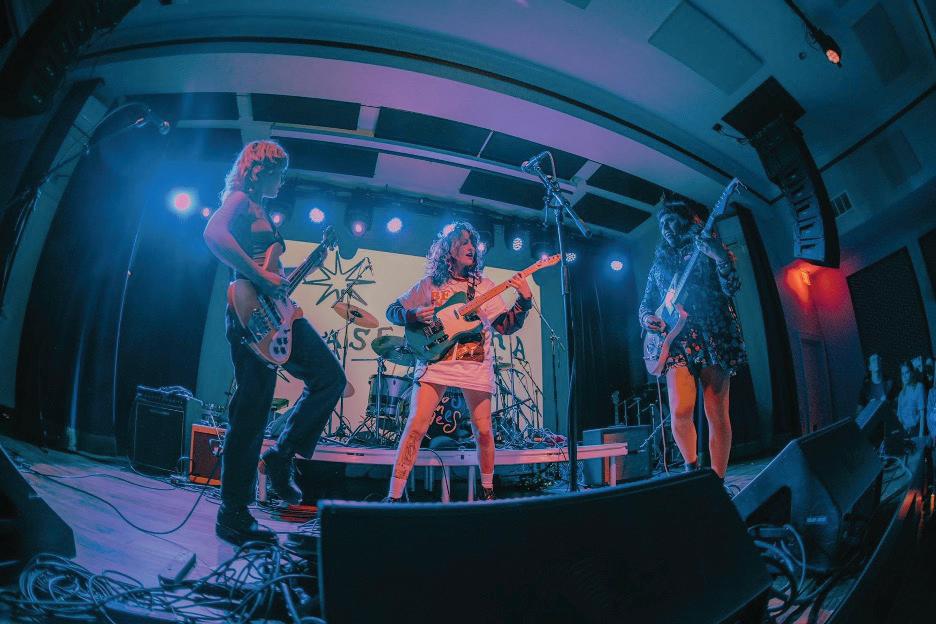
Their latest EP, “4 o’clock in the afternoon”, is available for streaming everywhere, as well as their recent single, “Reliable Narrator,” along with an accompanying music video. Allen sat down with the Wake to talk about their origins, perseverance, touring, and Keanu Reeves.
: How long have you been performing music professionally?
A: We started quite some time ago. I was fresh into community college and had been playing in bands for a while throughout high school and my teenage years. And when I got into community college, it was just becoming more and more apparent that, you know, people were moving on and, starting their degrees, getting careers, they weren’t really bothering with music anymore. And I was still trying so hard to, like, hold onto the dream, and it was really, really di cult to keep up the energy, but by persevering and kind of pushing through it, regardless of those feelings.
: When did you guys start together as a group, and what’s been your career trajectory?
A: I think we started technically under the name Chase Petra in like 2017 or 2018. But Evan, Brook, and I started o cially being a band, probably closer to the end of 2018,
and really finding our footing then. So it’s been five years now. And frankly, we have no idea what we’re doing in terms of our career trajectory. We’ve always just tried to stay open to the opportunities, and as time has passed, we’ve just gotten bigger opportunities, and it’s been really exciting to see the e ort of the past five years actually pay o . So again, like there’s no real master plan per se. I wish that I was a bit more of a planner or a bit more of a business person, but it’s super go-with-the-flow right now. That’s how we ended up in Minneapolis because somebody reached out to us and was just like, Hey, is this something you’d be interested in? And we’d never done it before. And we just decided, well, like, fuck it, let’s do it because, you know, somebody o ers you something new, why not?
: How would you describe your sound?
A: That’s a great question. I don’t know. There was a period when we were calling ourselves a quarter-life crisis, pop-rock, and that was kind of a joke, but kind of not a
22 MARCH 20 – APRIL 10 Q & A
joke, you know what I mean? On the internet, we’ve been called pop-punk and pop-rock. I heard another one recently that was a genre I had never even heard of before. But I’m gonna say pop-rock music is probably the most accurate descriptor.
: What has touring been like?
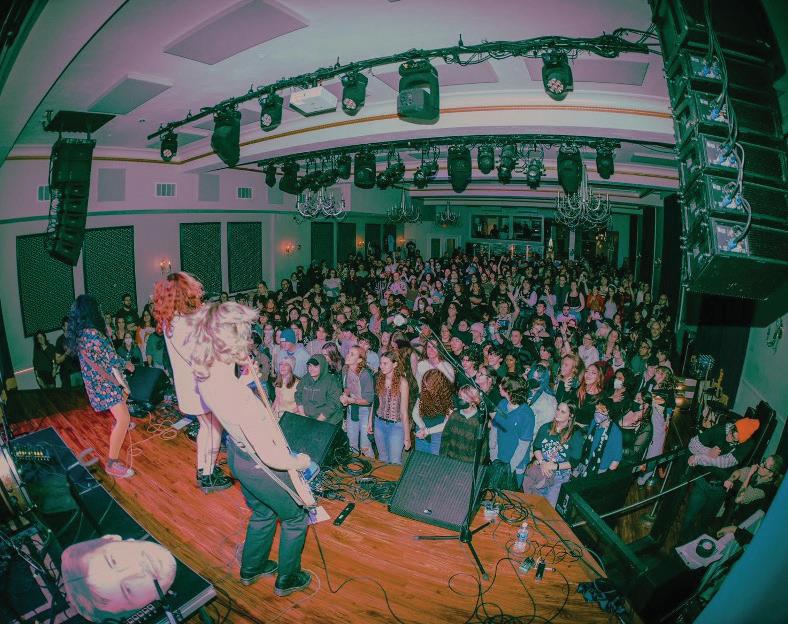
A: Well, we went on our first major tour in November and December. We had just come out with our EP, 4 o’clock in the afternoon, and it being our first time, you know, we were nervous, we were scared. Touring is new for us and a burgeoning part of our career. Minneapolis is actually just a one-shot for us. So we’re actually just flying out and playing the show and then coming back home.
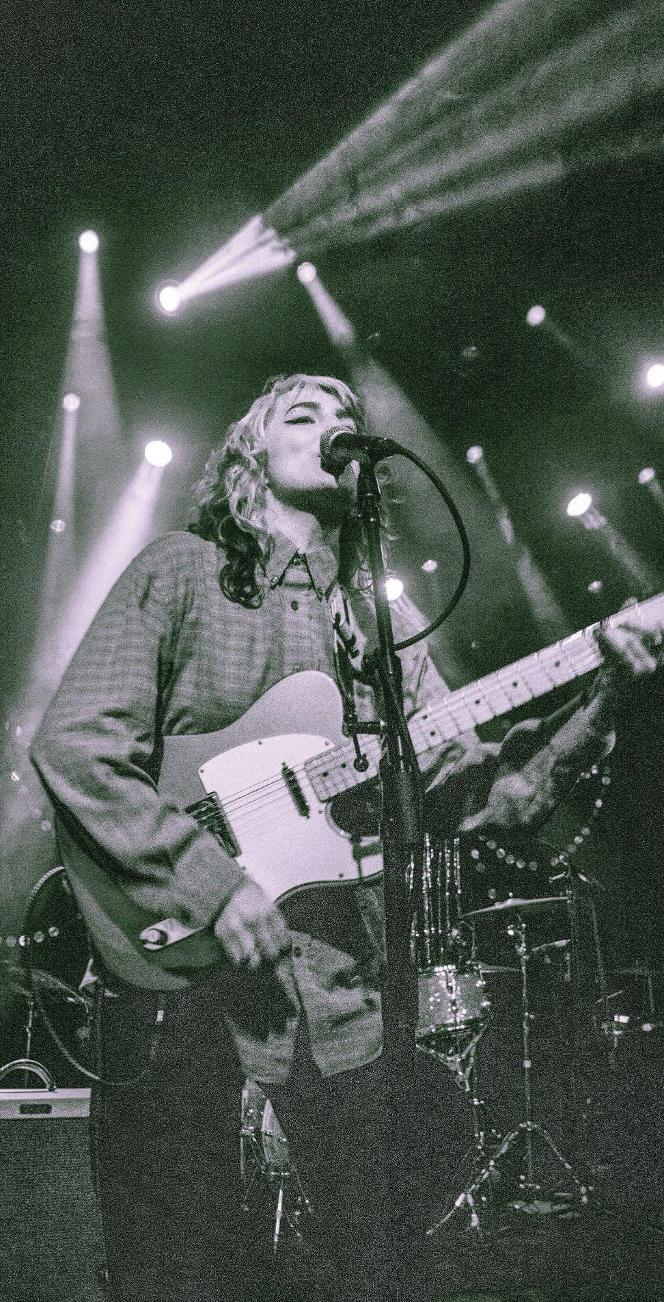

: I saw that you guys are going to Europe in the fall. How did that come together, and are you looking forward to that?
A: A booking agent from Europe literally just emailed our booking agent and was like, would they be interested in going to Europe? And you know, like, we have fans internationally, but it had never occurred to us to make that leap. But again, when the opportunity arises, if you can make it work, we’re just gonna make it work. And I’m so, so excited. I’m a little nervous cuz like, obviously, the tour life is new to us. We’re gonna be touring mostly in the U.K., so at least we’ll be able to read stu . [Laughs]
: You guys just released a music video for your song “Reliable Narrator” could you explain how that came together and sort of the aesthetics you chose?
A: The video was kind of inspired by early Panic! At the Disco vibes. We worked on it with an old friend that we’ve made music videos with for years, but we just decided to kind of like step it up a bit more this time and put a little bit more pre-planning and thought, and e ort into it. And I think it really paid o like it’s my favorite music video we’ve ever made. I was so happy with how it came out. The invitation for the video was literally just like, wear your craziest outfit. Like, feel good, look hot, do what you wanna do. So, a bunch of our friends came and dressed up in corsets and heels, and it was so much fun.
: Lastly, can you explain the Keanu Reeves cardboard cutout video? (Go to their Instagram @chasepetra to see what I’m talking about)
A: [Laughs] We have a song called Keanu Reeves, and it’s one of our singles o our last EP, and it’s just a part of the lyrics. Like the song isn’t about Keanu Reeves. But, like, it’s a fun name for a song. And we had been joking about needing a cardboard cut out of him for so long, and then in the middle of our tour in the Midwest, I think we were in Columbus, Ohio, this person had printed the cardboard cut out of Keanu Reeves, and it is one of the funniest, coolest things, anyone has ever done for us. It was such a beautiful
THE WAKE Q & A
moment in the career of this band. We have it hanging up in the studio now; it’s a beacon of hope for us.
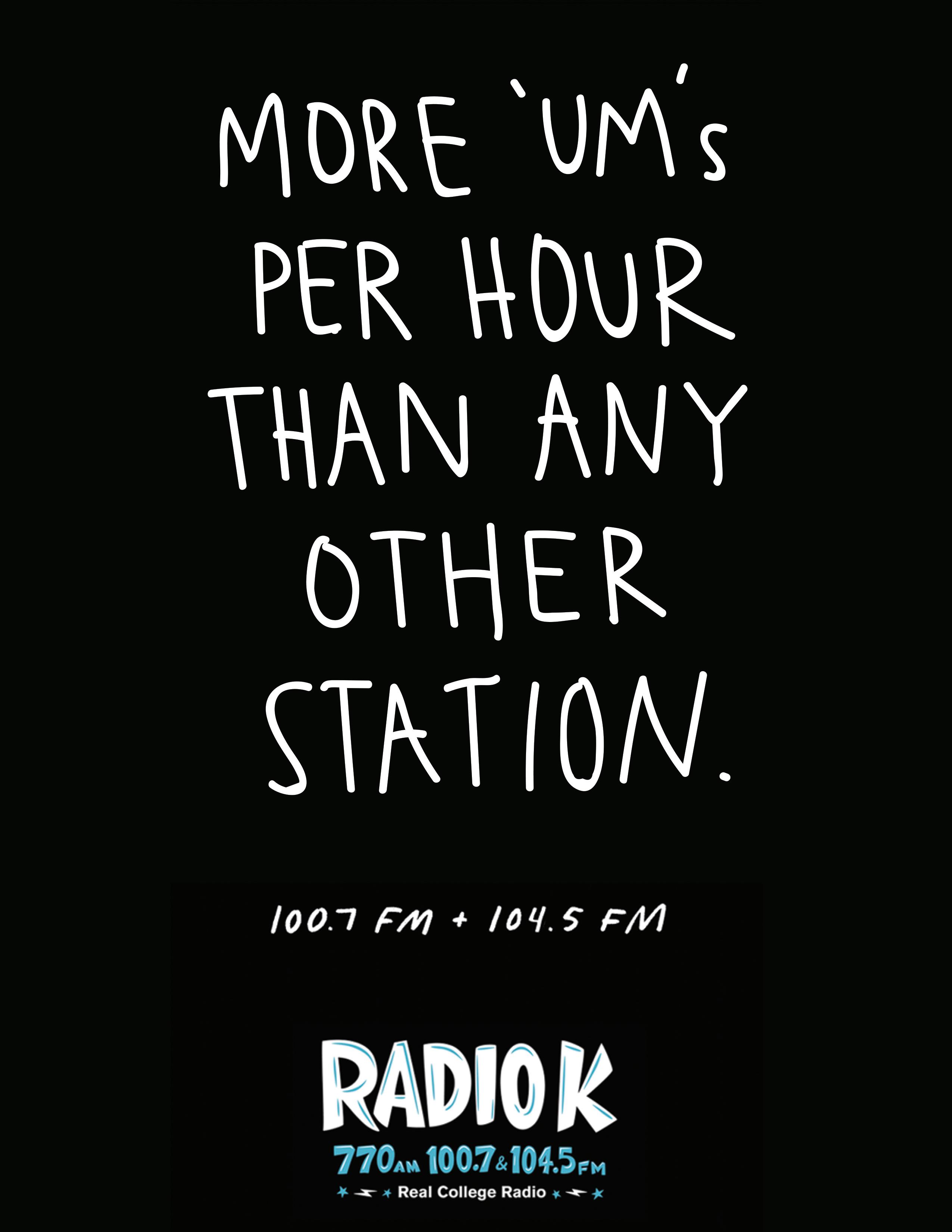













 BY MANSEE MANE
BY MANSEE MANE
 Art by Laura Kuchar
Art by Laura Kuchar












 BY JONATHAN SANTIAGO
BY JONATHAN SANTIAGO





